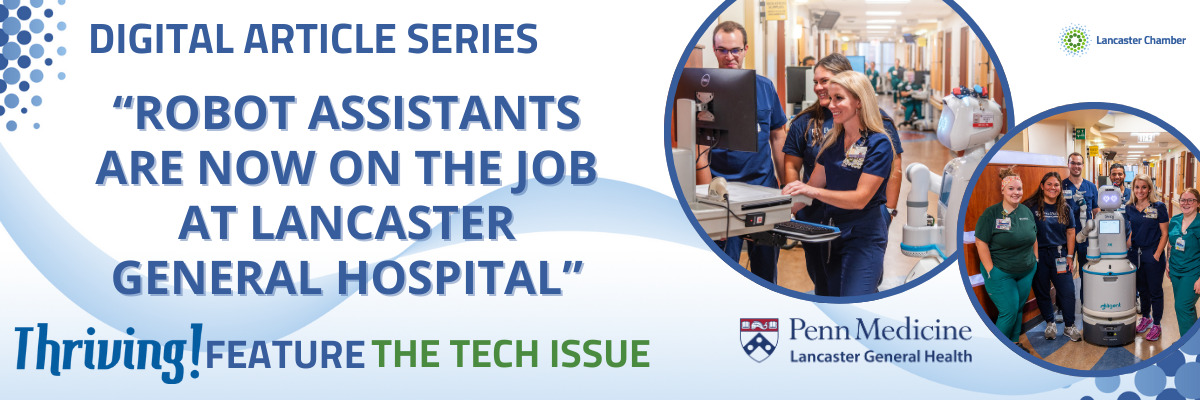A feature piece from our Fall 2024 TECH issue of the Lancaster Thriving Publication.
The Nursing staff at Penn Medicine Lancaster General Hospital (LGH) has some new helping hands in the form of two robot assistants. “Roxy” and “Rosie” help with routine non-clinical tasks, such as pickup and delivery of supplies, enabling nurses to focus on patient care.
Chief Nursing Officer Tim Zellers, MBA, MSN, CRNP, said the hospital’s nurses get pulled in many different directions during a typical shift. In fact, the robots’ creator, Diligent Robotics, estimates that 30 percent of nurses’ time is spent retrieving and gathering supplies, such as personal protective equipment, lab samples and medications.
“This is one way of limiting those tasks that don’t necessarily require a nurse but can help support them in their role,” Zellers said. “The robots allow nurses to actually focus on what they’re trained to do, and that’s to take care of patients.”
Like other industries, such as restaurants and retirement communities, health-care organizations are increasingly utilizing robots and other artificial intelligence to complete routine tasks. Diligent builds robots specifically to assist nurses and other members of the health-care team. While its robots are in use in hospitals across the country, LGH is the first hospital in Pennsylvania to engage them.
Navigating the hallways of the 525-bed hospital autonomously, including the elevators, Roxy and Rosie deliver and pick up routine lab specimens, such as urine samples or COVID swabs, as well as boxes that contain heart monitoring equipment. (Specimens that are deemed urgent or require special handling are carried by humans.)
To request one of the robots to complete a task, a staff member uses an iPad kiosk located throughout the hospital, and pickups and deliveries are kept secure using a badge swipe. Each robot has three drawers of different sizes, making it possible to deliver several items, or to multiple locations, at once.
The robot’s response time depends on the other tasks already in the queue. Roxy and Rosie are in service 22 hours a day, spending the other two charging on docking stations located throughout the hospital. They can also navigate to a docking station for a “nap” when not in use.
Roxy and Rosie – who were named through a contest held by the nursing staff – are equipped with sensors to detect obstacles and will either stop or go around them. (They’re polite while doing so, saying, “Pardon me, may I get to that spot, please?” to announce themselves to passersby in the halls.)
The robots do not enter patients’ rooms or interact with patients. But with their blinking heart eyes, friendly “chirps,” and willingness to pose for selfies, they are a source of fascination and delight for many hospital visitors and staff alike.
Zellers said the robots are not meant to replace people or fulfill jobs that are currently done by nurses or other clinical staff. Instead they work side-by-side to support clinical staff, helping them to save time and do their jobs more efficiently.
“The robots assist our clinical team with tasks that take them away from the bedside, so they can devote more time to patient care,” he said. “It improves the experience, certainly, for our patients, who get to spend more face-to-face time with the staff taking care of them.”
Allen Cubell, LG Health Executive Director of Innovation, said the two-year robot pilot is just one example of Penn Medicine’s continued investment in innovations that make health-care workers’ jobs easier. The robots are a very visible example of those efforts, which also include initiatives to reduce the time providers spend on documentation and inbox management.
The team is considering other possible uses for the robots, such as transporting patient care equipment during the overnight hours, or delivering a utensil or condiment that is inadvertently missing from a patient’s food tray.
“It’s possible that we will add more robots in the future,” Cubell said. “Roxy and Rosie are high-tech, and they’re fun too. There’s no question that innovations like these are the future of health care.”
not secure

